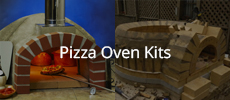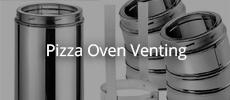There are two main problems, both associated with the presence of water. Firstly that of steam spalling which occurs when water suddenly turns to steam, expands and blows apart the wall from the middle. Water closer to the surface has a better chance to escape so it's the water in the middle that is the problem. As water's boiling point begins at 100C (212F) do not assume it's safe once the temperature gets to around 150C. In fact as most potters know, most steam spalling occurs at around 250-280C
Secondly because the top of the dome gets hotter faster, primarily because of rising heat due to convection, there is a huge difference in temperature between the crown of the dome and the base, which also leads to a huge difference in thermal expansion. (As an aside heat doesn't care what direction to travel by radiation or convection.) The problem is exacerbated if moisture is present because water will hold the temperature down. A considerable amount of energy is required to convert water to steam. So, this problem is further aggravated as the moisture is driven out of the top of the dome leading to a more rapid rise of temperature there and the resulting increased difference in both temperature and thermal expansion. Allowing the whole oven to return to ambient temperature after a fire therefore allows you to begin with an equal start again. It probably also allows some migration of moisture to even out over the whole dome. This is why a series of fires, usually 7 fires in 7 days is more successful than a continuous long fire.
Once this initial process has been completed, if the oven gets wet again, it is not mandatory to return to such a careful regime. Usually one or two long fires are a sufficient remedy to return the oven to normal working order.
Announcement
Collapse
No announcement yet.
Another curing question
Collapse
X
-
Ahhh I see. Thanks for finding that for me. So I'm still trying to understand the science behind cracking - am i correct in saying all cracks in a wfo initially start due to moisture still in the masonry? If that is the case, then grinding and filling in after all moisture has escaped would remedy the problem? Or can a wfo still crack even though all moisture is removed? I'm not really worried about the cracks in ours but just trying to understand the science behind it all.
Leave a comment:
-
Here's a link to Karangi Dudes very well documented barrel vault oven. Some good discussion on buttress use about post 13. Consistent oven cracks that return to their original position is fabulous! Honesty not sure if grinding out the cracks & patching is worth it. When the oven expands during firing, those forces will always cause a break at weak points (consider them expansion joints). In addition, it is almost impossible to get a good bond and a crack patch will very likely crack itself & simply fall out. Better to leave the known cracks alone and just keep an eye on them. Relax! Cracks are a badge of honor for a well used oven!
After a long illness I have finally started to build a bread oven for our new WFO and cooking classes, The oven needs to be built first before we close in the 9metres x 5metres room, only the entrance of the oven will be in the kitchen with rest of the oven outside. With the floor height 500mm of the ground
Leave a comment:
-
so far its the same cracks opening and closing. One linear crack about 3 courses down from the top {outer common brick layer} and one smaller one on the other side. Some minor hairline cracks in the joints on the back wall. Overall it cooks and burns well though. I'll get around to grinding them out and filling them in with heat stop soon.
Leave a comment:
-
I'll look for a good example for you. The flying buttress developed for the large churches in Europe is the classic example...but obviously your oven doesn't have a large, structure weight pressing the sides outward excessively. Generally for a buttress, you're just adding some brickwork along the lower wall sides of the arch to keep those bricks from any lateral movement. Some builders have even used metal strapping to prevent this potential for progressive shifting outward. Again no big worries, just something to keep an eye on and if the oven does start displaying evidence of a consistent & outward movement, adding some buttressing would solve the issue.
Leave a comment:
-
Thank you Mike. Would you happen to have an example of "buttressed on the outside " so I can see what you mean?
Leave a comment:
-
The normal brick expansion during firing will represent itself in the cracks opening up...this is not a result of retained moisture at this point. The "old school" bakers would often use the crack's size as an indicator for the oven's heat saturation & temp. Domes are normally very stable structurally and the expansion/contraction is consistent...in the half barrel design, such as yours, the outward forces may cause shifting of the bricks. This shifting can result in the barrel's collapse as the bricks work their way outward. Most ovens that use this design are buttressed on the outside to keep the bricks from the tendency for outward movement. You might consider doing that for your oven if you notice the cracks getting bigger & not closing back up when the oven cools. I don't want to "strike fear" in your heart...your build looks great...just something you need to be aware of... Last edited by SableSprings; 11-01-2022, 07:25 AM.
Last edited by SableSprings; 11-01-2022, 07:25 AM.
Leave a comment:
-
We used the oven all day yesterday, topped out at about 700 degrees give or take. Pizza was awesome, took about 5 minutes per pie . The same cracks are opening up every time we fire it. Does this mean there is still moisture somewhere or is this common even when fully cured?Last edited by pmgnut; 10-31-2022, 06:10 AM.
Leave a comment:
-
-
Well since my last post we have done 8 curing fires and even cooked a frozen pizza just for kicks to see how it would work. The frozen pizza was the cheapest money could buy and not a brand I'd normally purchase for my regular electric home oven. Doctored it up with some olive oil and oregano it i have to say it was beyond delicious with the wood fired flavor. Bottom crust cooked beautifully. As for cracking- yes we did get two linear cracks on the bed joints on the outer red brick layer. The cracks are hardly noticeable when the oven is cold but when it heats up, the same cracks open up every time. Also a few hairline cracks in the back firebrick wall {joints} but as I said they are hairline cracks and do not appear to be an issue. I'm going to wait a while to grind out and fill the cracks in, as i want to see if any additional ones develop first, this way i can do it all at once. Overall the oven heats very nicely inside and burns quite well. A couple things we noticed - oven takes a good 60 to 90 minutes to get really get hot for cooking. The other thing is the obvious- the drier the wood the hotter and better it will burn
Last edited by pmgnut; 10-24-2022, 08:14 AM.
-
Thanks for the reply. I ended up using charcoal briquetes last night, started with a pile and added more as they heated up. Eventually had one single layer spread evenly across the entire oven floor, front to back, it had a nice even steady heat, hoovering around 200 to 220. I let it burn out naturally.
Leave a comment:
-
Hi pmgnut, there is no hard and fast rules for curing an oven and there are also a lot of variables for each oven like construction type, type of mortar, thickness, oven size, insulation, climate etc.
The first step is to wet cure the Portland cement/mortars for 7 days followed by up to 14 days dry cure for your cement/mortar to reach design strength. (This is the ideal, most people struggle with 14 days total)
After that the goal is to drive out the significant amount of moisture held in the oven using a heat source without turning the moisture to steam.
In my experience the ideal way to do this is with a controlled heat source like an electric or propane heater to heat the oven to MAX 200°f and hold it at that temp for as long as nessasary to remove the bulk of the moisture, which could be several days or more.
Next comes the curing fires at progressively higher temps on a daily basis up to 7 days. Here, the idea is to heat the oven to the progressive temperature for an hour or two to allow the oven mass to saturate then seal the oven and let it sit whilst the heat progresses through the oven mass and insulation with the oven retaining more and more heat as the firings progress each day and fully drying the oven.
Each oven is different, everyone cures their oven differently, some not at all. Slow and long is appropriate, as is observation on how your oven is behaving. Worst that can happen is you get a minor crack.
Enjoy
Leave a comment:
-
What is the correct method of curing? I have read where one should peg the max desired temp then burn for minimum 3 or 4 hours {longer the better} then in the sticky section i read it mentions "Let the oven fall back to cool as soon as you reach the temperature you want. " , its awfully confusing
I also just read the Forno Bravo instructions where it says do not use charcoal for curing
When curing your wood fired oven, only use solid wood fuels.- DO NOT USE charcoal, pressure treated lumber, chipped wood products, sappy wood such as pine, laminated wood, or any material other than dry, medium- or hard-firewood.
Last edited by pmgnut; 09-26-2022, 12:40 PM.
Leave a comment:
-
Thank you Sixto, I don't have a welder so I just drilled , bolted and screwed together, it's a pretty solid door
Leave a comment:





Leave a comment: